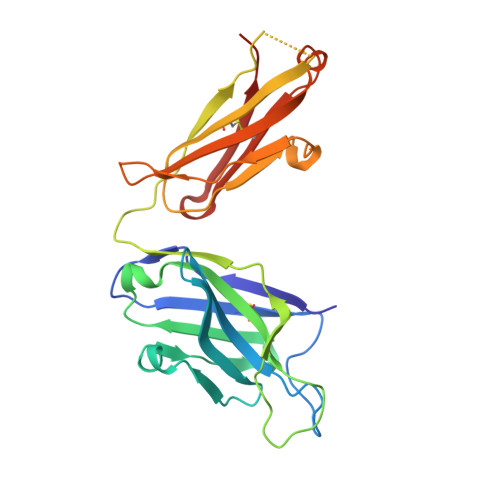Supersite of immune vulnerability on the glycosylated face of HIV-1 envelope glycoprotein gp120.
Kong, L., Lee, J.H., Doores, K.J., Murin, C.D., Julien, J.P., McBride, R., Liu, Y., Marozsan, A., Cupo, A., Klasse, P.J., Hoffenberg, S., Caulfield, M., King, C.R., Hua, Y., Le, K.M., Khayat, R., Deller, M.C., Clayton, T., Tien, H., Feizi, T., Sanders, R.W., Paulson, J.C., Moore, J.P., Stanfield, R.L., Burton, D.R., Ward, A.B., Wilson, I.A.(2013) Nat Struct Mol Biol 20: 796-803
- PubMed: 23708606
- DOI: https://doi.org/10.1038/nsmb.2594
- Primary Citation of Related Structures:
4JM2, 4JM4 - PubMed Abstract:
A substantial proportion of the broadly neutralizing antibodies (bnAbs) identified in certain HIV-infected donors recognize glycan-dependent epitopes on HIV-1 gp120. Here we elucidate how the bnAb PGT 135 binds its Asn332 glycan-dependent epitope from its 3.1-Å crystal structure with gp120, CD4 and Fab 17b. PGT 135 interacts with glycans at Asn332, Asn392 and Asn386, using long CDR loops H1 and H3 to penetrate the glycan shield and access the gp120 protein surface. EM reveals that PGT 135 can accommodate the conformational and chemical diversity of gp120 glycans by altering its angle of engagement. Combined structural studies of PGT 135, PGT 128 and 2G12 show that this Asn332-dependent antigenic region is highly accessible and much more extensive than initially appreciated, which allows for multiple binding modes and varied angles of approach; thereby it represents a supersite of vulnerability for antibody neutralization.
Organizational Affiliation:
Department of Integrative Structural and Computational Biology, The Scripps Research Institute, La Jolla, California, USA.















